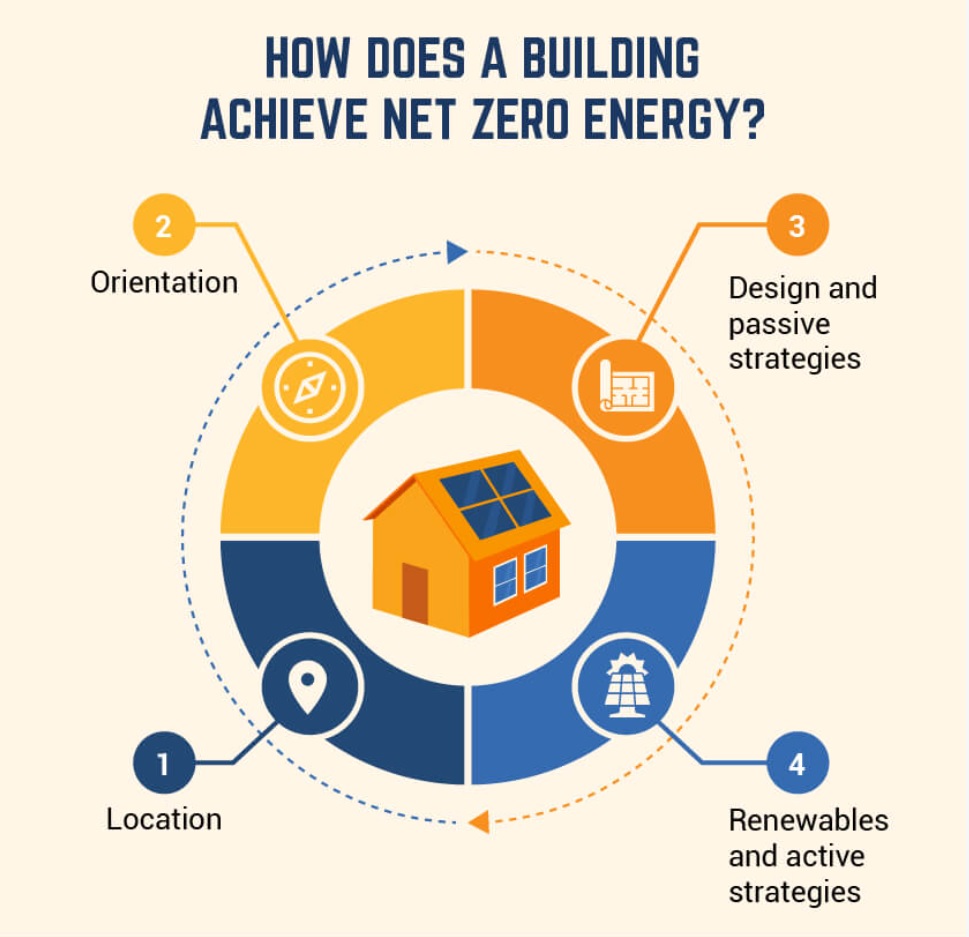How does building orientation affect energy efficiency? Building orientation has an impact on how much sunlight a structure receives as well as its insulation levels—both of which are critical factors when it comes to energy efficiency.
In this blog post, we will explore five different aspects related to building orientation and energy efficiency: sun exposure, design and insulation elements, HVAC systems, entry points within structures, and lighting solutions.
So how does building orientation affect energy efficiency? Let’s dive in.
Table of Contents
Building Orientation and Sun Exposure
How does building orientation affect energy efficiency?
Building orientation and sun exposure can have a significant impact on energy efficiency. Sun exposure can be used to reduce the need for artificial lighting, while also providing natural warmth during the winter months. Understanding how building orientation and sun exposure affect energy efficiency is important when designing or renovating a commercial building.
Effects of Sun Exposure on Energy Efficiency
The direction in which a building faces has an effect on its energy efficiency. Buildings that are oriented towards the south will receive more direct sunlight than those facing other directions, making them more efficient in terms of heating costs during colder months.
Meanwhile, buildings with large windows or skylights will allow more light into the interior spaces, reducing reliance on electric lighting and cooling systems.
Benefits of Natural Light
Natural light provides numerous benefits beyond just saving money on electricity bills. It can also improve mood by increasing serotonin levels in humans as well as provide vitamin D from UV rays that enter through windows or skylights.
It’s been proven to increase productivity among workers since they don’t have to rely solely on artificial lights for illumination throughout their workday.
Furthermore, natural light helps regulate circadian rhythms better than any type of artificial lighting system available today.
Building Design and Insulation
Insulation is a key component of how does building orientation affect energy efficiency. Different types of insulation materials are available on the market today, each with its own unique characteristics and benefits.
Fiberglass insulation is one of the most common types used in building construction. It comes in rolls or batts and can be easily installed between wall studs or ceiling joists.
Cellulose insulation is made from recycled paper products and offers good soundproofing capabilities as well as fire resistance.
Foam board insulation consists of rigid panels that fit snugly into walls and ceilings to provide an airtight seal against heat transfer.
Spray foam insulation expands to fill cracks and crevices for a more complete coverage than traditional fiberglass or cellulose insulations.
Soundproofing capabilities are also important if you want your office spaces to remain quiet, so make sure you select an insulation material that provides adequate sound-dampening properties.
Lastly, proper ventilation systems must always be installed alongside any form of building insulation since they work together towards achieving optimal energy efficiency results. This combination ensures that temperature fluctuations throughout different seasons have no negative impacts on indoor comfort levels.
HVAC Systems
HVAC systems are an important part of maintaining energy efficiency in buildings. Different types of HVAC systems are available on the market today, each with its own benefits and drawbacks.
Central air conditioning systems are one of the most common types of HVAC systems used in commercial buildings. These systems provide cooling during hot summer months as well as heating during cold winter months, making them a great all-in-one solution for climate control throughout the year.
Heat pumps use electricity to transfer heat from one area to another, providing both heating and cooling capabilities while using less energy than traditional central air conditioning units.
Furnaces rely on natural gas or propane fuel sources to generate heat which is then distributed through ducts throughout the building, providing efficient warmth during colder weather conditions.
Boilers use heated water instead of air to distribute warmth throughout a building’s interior spaces while geothermal systems utilize underground temperatures to help regulate indoor climates.
Ductless mini-splits are also becoming increasingly popular due to their ability to provide localized temperature control without requiring extensive installation work as traditional ducted models do.
Proper ventilation is essential for maintaining energy efficiency in buildings by removing excess moisture from indoor air which can lead to mold growth if left unchecked.
Regularly changing filters and scheduling regular maintenance checks with a professional technician are important strategies for optimizing HVAC performance.
 (Source)
(Source)
Windows, Doors, and Skylights
Windows, doors, and skylights are important components of any building’s design that can have a significant impact on its energy efficiency levels. There are several types of windows available on the market today including single-pane windows with low-emissivity coatings (Low-E), double-pane windows with gas fillings between panes (argon or krypton), and triple-pane windows with Low-E coatings or gas fillings between panes (argon or krypton).
When choosing windows for your building, there are several factors to consider such as U-factor ratings (the rate at which heat is transferred through a window), Solar Heat Gain Coefficient ratings (the amount of solar radiation that passes through a window), and visible transmittance ratings (the amount of visible light that passes through a window).
There are also strategies for maximizing the efficiency of windows in buildings.
Installing storm windows over existing single-pane windows is one way to increase energy efficiency by reducing air leakage around the frame and preventing drafts from entering.
Additionally, using shades or blinds to keep hot air outside and cool air inside can help reduce cooling costs significantly.
Skylights provide an alternative source of illumination during daylight hours — totally free of charge.
Doors should be chosen based on their insulation properties. Solid core wood doors offer better insulation than hollow core wood doors do and fiberglass entry doors provide superior thermal performance compared to steel entry doors.
Lighting Solutions for Energy-Efficient Buildings
LEDs offer superior energy efficiency compared to other types of lighting solutions, making them ideal for long-term use.
Fluorescent lights provide bright light at a lower wattage than traditional incandescent or halogen lamps, making them more cost-effective.
Halogen lamps provide bright white light but can be expensive due to their high wattage requirements.
Incandescent bulbs produce warm yellowish light but are not as efficient as other options and require frequent replacement due to their short lifespan.
The environmental impact should also be considered when selecting lighting solutions as some products may contain materials that are hazardous to people and wildlife if disposed of improperly.
Additionally, certain lighting solutions may have a bigger carbon footprint than others due to the materials used in their production process.
FAQs About How Does Building Orientation Affect Energy Efficiency
Why is the orientation of a building important?
The orientation of a building is a measure of how its front faces in relation to the sun. Azimuth is the measure of the angle between the true north and the front of the structure. When successful, the orientation of the building and its location on the site can take advantage of other natural elements, such as wind or rain.
What factors can affect the efficiency of a building?
- The occupancy of the building.
- The insulation of the building.
- Window type and shading.
- Heating, Ventilation, and Air Conditioning (HVAC) schedules.
What is the optimum orientation for a building?
The best orientation for a building is north. However, orientations of up to 15° west of north and 25° east of north still allow good sunshine. Orientation towards the east or west can both be advantageous in some regions and for some types of activity.
Conclusion
It is clear that building orientation does affect energy efficiency. By considering the sun exposure of a building, its design and insulation, HVAC systems, entry points, and lighting solutions, builders can create structures that are both aesthetically pleasing and environment-friendly.
Ultimately, by understanding how does building orientation affect energy efficiency, we can make better decisions about our buildings’ designs for improved sustainability.
{“@context”:”https:\/\/schema.org”,”@type”:”FAQPage”,”mainEntity”:[{“@type”:”Question”,”name”:”Why is the orientation of a building important?”,”acceptedAnswer”:{“@type”:”Answer”,”text”:”
The orientation of a building is a measure of how its front faces in relation to the sun. Azimuth is the measure of the angle between the true north and the front of the structure. When successful, the orientation of the building and its location on the site can take advantage of other natural elements, such as wind or rain. “}},{“@type”:”Question”,”name”:”What factors can affect the efficiency of a building?”,”acceptedAnswer”:{“@type”:”Answer”,”text”:”
- \n\t
- The occupancy of the building.\n\t
- The insulation of the building.\n\t
- Window type and shading.\n\t
- Heating, Ventilation, and Air Conditioning (HVAC) schedules.\n
- The occupancy of the building.
- The insulation of the building.
- Window type and shading.
- Heating, Ventilation, and Air Conditioning (HVAC) schedules. “}},{“@type”:”Question”,”name”:”What is the optimum orientation for a building?”,”acceptedAnswer”:{“@type”:”Answer”,”text”:”
The best orientation for a building is north. However, orientations of up to 15\u00b0 west of north and 25\u00b0 east of north still allow good sunshine. Orientation towards the east or west can both be advantageous in some regions and for some types of activity. “}}]}





